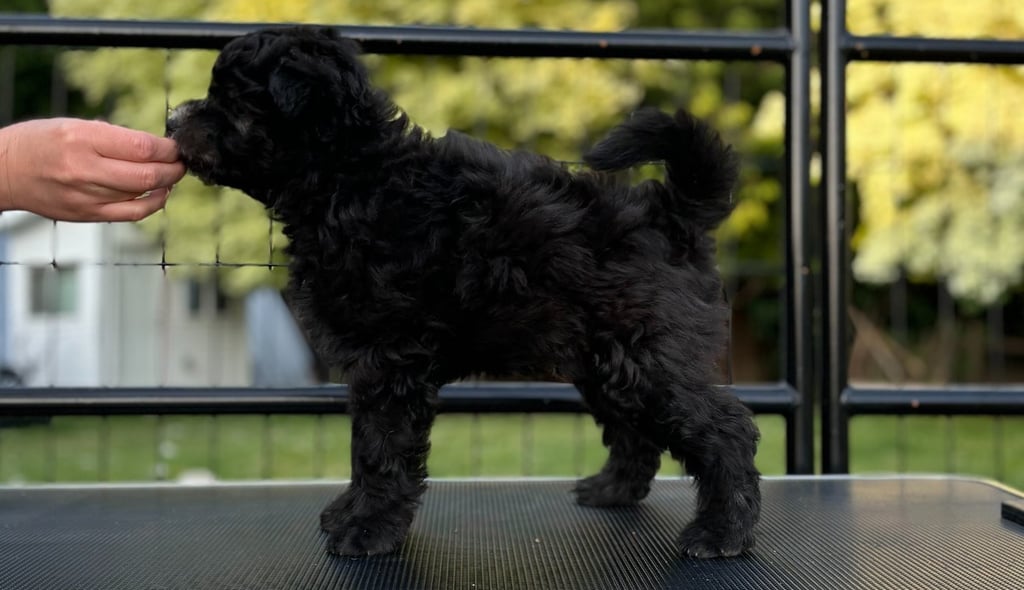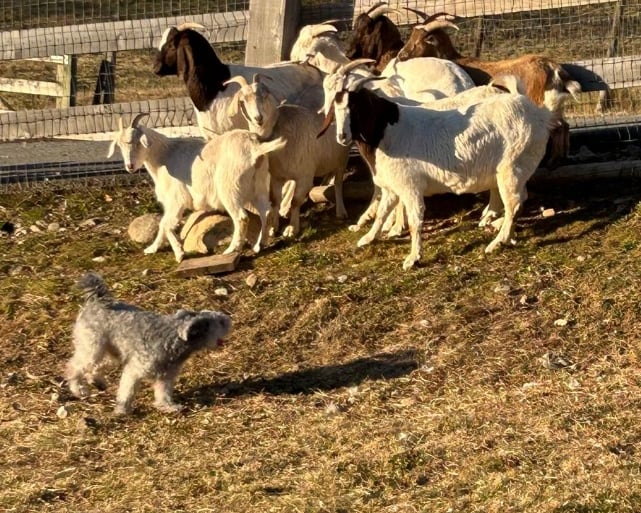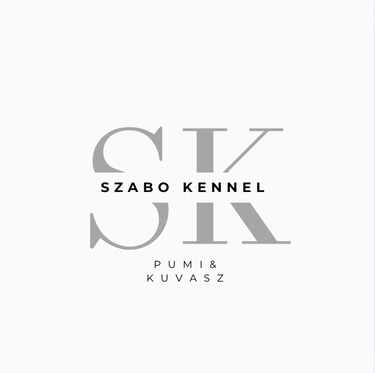Comitted to excellence in breeding hungarian Pumi and HUngarian kuvasz
Hungarian Pumi
Introduction
The Hungarian Pumi is a unique and energetic dog breed with a rich history and distinct personality. Originally bred as a working dog, the Pumi excels in herding, guarding, and companionship. This page will guide you through the essentials of understanding and caring for a Hungarian Pumi, from its history and breed standard to its grooming and health needs.
History of the Hungarian Pumi
The Hungarian Pumi a breed that originated in Hungary. The Pumi is believed to have evolved from a combination of various herding dogs brought to Hungary by nomadic tribes in the 17th century. The breed was specifically developed to herd livestock, such as sheep and cattle, in the mountainous regions of Hungary.
The Pumi's versatility and intelligence allowed it to adapt to various tasks over the centuries, including herding livestock and alerting as watch dogs. By the early 20th century, the Hungarian Pumi had become well-established as a distinct breed and was officially recognized by the Fédération Cynalogique Internationale (FCI) in 1966.
Physical Characteristics and Breed Standard
Size and Appearance
The Pumi is a medium-sized, compact dog, standing between 15 to 18 inches tall at the shoulder and weighing 18 to 30 pounds. The breed is known for its lively and energetic appearance, with a strong, athletic body. Its coat is one of the most distinctive features — it is wavy or curly and typically has a slightly tousled, textured look.
Breed Standard Highlights
The Pumi is a medium-sized herding dog from Hungary, recognized by the Canadian Kennel Club (CKC) as of July 2024. This breed combines agility, intelligence, and a distinctive appearance, making it both a capable working dog and a charming companion.
General Appearance:
The Pumi presents a well-proportioned, square outline that conveys quality, gracefulness, and perfect balance.
Size:
Height:
Males: 16.25 to 18.5 inches (41 to 47 cm) at the withers.
Females: 15.5 to 17.5 inches (39.5 to 44.5 cm) at the withers.
Weight:
Males: 24 to 29 pounds (10.9 to 13.2 kg).
Females: 18 to 24 pounds (8.2 to 10.9 kg).
Coat:
The Pumi's coat is medium in length, dense, and consists of wavy or curly hair that is elastic and shaggy in appearance. The texture should be such that the coat forms distinct curls, contributing to the breed's characteristic look.
Color:
Acceptable colors for the Pumi's coat include black, white, gray, and fawn. These colors can appear in various shades and combinations, but any colors outside of these are considered undesirable.
Head:
The head is relatively long and narrow, with an elongated muzzle. The jaws are strong, and the cheeks are well-muscled, contributing to the breed's keen expression.
Neck:
The neck is of medium length, slightly arched, and blends smoothly into the shoulders. It supports the head gracefully, allowing for free movement.
Forequarters:
Shoulders: The shoulders are well laid back, muscular, and clean, allowing for efficient movement.
Legs: The forelegs are straight, with strong bone structure, and are set well apart to support the body.
Pasterns: The pasterns are slightly sloping but strong, providing a solid foundation for the forequarters.
Body:
The body is square, with the length of the body from the withers to the root of the tail equal to the height at the withers. The back is straight and strong, leading to a well-muscled loin and a deep, well-sprung ribcage that extends to the elbows.
Hindquarters:
Thighs: The thighs are muscular, broad, and strong, providing the drive necessary for the Pumi's herding activities.
Hocks: The hocks are well let down, strong, and parallel when viewed from behind, ensuring stability and power in movement.
Tail:
The tail is set high, carried over the back, forming a loop with the tip touching the back. It is covered with wiry hair, contributing to the breed's distinctive silhouette.
Temperament and Personality
The Hungarian Pumi is known for its high energy, intelligence, and alertness. These dogs are friendly, affectionate, and make excellent family companions, but they are also independent and protective. They are very attached to their families and can be wary of strangers.
Intelligent: Pumik are quick learners and excel in training, particularly in tasks that require problem-solving.
Energetic: Due to their history as working dogs, Pumik have high energy levels and need ample physical and mental stimulation.
Protective: They have strong guarding instincts, making them excellent watchdogs.
Affectionate: While they can be reserved around strangers, Pumik are loyal and loving with their family members.
Working Abilities and Training
The Hungarian Pumi's working background makes it an ideal dog for tasks such as herding, guarding, and dog sports such agility and dock diving. They excel in obedience training and agility sports, thriving on challenges that require focus and physical exertion.
Herding
Pumik are natural herders. They were bred to work independently or with minimal guidance from their handlers, making them excellent partners for experienced dog owners who engage in livestock management.
Training
Given their intelligence, Pumik tend to do well with positive reinforcement training methods. They require consistent training to keep them mentally stimulated. Early socialization and exposure to various environments are important to prevent excessive shyness or overprotectiveness around strangers.
Grooming and Coat Care
The Pumi's coat is one of the breed's most distinguishing features, but it also requires regular maintenance to keep it looking its best.
Coat Maintenance
The Pumi has a thick, curly coat that requires regular grooming. Combing once a week is essential to prevent matting. trimming by scissors is required every 4-6 weeks.
Bathing
Pumik don’t require frequent bathing unless they become dirty or muddy. Overbathing can strip the coat of its natural oils, leading to dryness.
Ear Care
Given their folded ears, it’s important to check and clean the ears regularly to prevent infections.
Health and Lifespan
The Hungarian Pumi is generally a healthy breed with a lifespan of 12 to 14 years. However, like many breeds, they can be prone to certain health conditions.
Common Health Issues
Hip Dysplasia: Like many medium-sized breeds, Pumik may develop hip dysplasia, a condition where the hip joint doesn’t develop properly, leading to arthritis and mobility issues.
Elbow Dysplasia: Like hip dysplasia, elbow dysplasia occurs when the elbow joint develops improperly, which can lead to arthritis and lameness.
Patellar Luxation: Patellar luxation is a condition where the kneecap (patella) dislocates from its normal position, causing pain and potentially limiting mobility.
Primary Lens Luxation: Pumik can be prone to Primary Lens Luxation (PLL), a condition that can lead to blindness.
Degenerative Myelopathy: Degenerative myelopathy is a neurological condition that affects the spinal cord and can lead to progressive paralysis.
Health Maintenance
Regular veterinary check-ups, a balanced diet, and routine exercise are important to keeping a Pumi healthy.
Pumi in Modern Times
Though the Hungarian Pumi is still used for herding in rural areas of Hungary, the breed has become increasingly popular as a companion dog around the world. In the United States, the Pumi was recognized by the American Kennel Club (AKC) in 2016, the Canadian Kennel Club (CKC) in 2024, and its popularity continues to grow. Pumik are well-suited for active families, dog sports enthusiasts, and those with experience in training working dogs.
Adopting a Pumi
Adopting a Pumi requires careful consideration. Due to their high energy and intelligence, they are best suited for experienced dog owners who can provide the mental and physical stimulation they need.
Finding a Pumi
It is crucial to find a reputable breeder who prioritizes the health and well-being of the dogs. Adoption from rescue groups or shelters is another option, though Pumik may not be as common in these environments.
Considerations Before Adoption
Are you prepared to provide the necessary exercise and mental stimulation for an active dog?
Do you have experience with working breeds or herding dogs?
Are you willing to invest time in grooming and coat maintenance?
Conclusion
The Hungarian Pumi is a remarkable and versatile breed that requires an active, engaged owner. Whether you are looking for a herding companion or a loyal family dog, the Pumi offers both intelligence and affection. With the proper care, training, and attention to its grooming needs, a Hungarian Pumi can make a wonderful and rewarding addition to your home.
By following the guidance in this article, prospective Pumi owners will be well-equipped to provide the best environment for their new companion, ensuring a happy and healthy life for both dog and owner.


A Complete Guide For Prospective Owners


Committed to Excellence
Dedicated to health and temperament in puppies.
inquiries:
szabokennel@gmail.com
© 2025. All rights reserved.
Charona Shannon
Follow Szabo Kennel on Instagram and Facebook for Updates!
